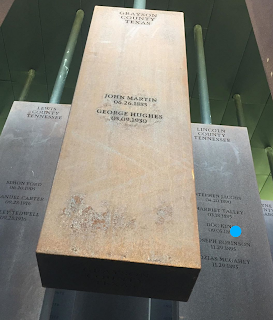History and Faith Invite Conversations
 |
| Photo Courtesy: Dr Randi Tanglen |
Recently as I drove through the Square in downtown Sherman, a demonstration caught my eye. A handful of older white men surrounded the Confederate memorial statue on the Grayson County Courthouse grounds. A larger group of about thirty, much younger people gathered on the sidewalk. It was obviously a public debate about the future of that statue, although the two groups were not talking to each other. We’ve seen this debate continue throughout our country this summer. What is the history of these memorials? What was their stated purpose at the time of their installation-- and what message, intended or not, is heard by the general public-- then and today? Thinking from a broader perspective, what is the function of history? And how does faith intersect with it?
The Grayson statue is one of the oldest anywhere: 1896. Most of the statues around the country, 800 or so, were erected during the Jim Crow era. Slavery was abolished, but African Americans did not enjoy the same freedoms as other Americans. Likewise, many schools were established, or re-named, after Confederate figures during the same era or following the Brown v. Board of Education Supreme Court ruling (1954) and the Civil Rights movement of the 1960s. Here is a helpful article that traces the history of public schools and monuments on public grounds and their relationships to social change: https://projects.fivethirtyeight.com/confederate-statues/
A decade before the Grayson County Confederate memorial was established, an African American man, John Martin, was lynched in Bells. Two generations after the statue was dedicated, an African American man, George Hughes, was lynched in Sherman. A white mob, frenzied by rumors surrounding Mr Hughes’ case, was so enraged that they interrupted the trial several times before setting the courthouse on fire. Mr Hughes, trapped inside, died in the blaze. After destroying the courthouse the mob turned its wrath on many Black-owned businesses in town. Why am I bringing up the horrific events of 1885 and 1930? Because if we want to invoke history’s gaze on the present, we have to let it all out. Otherwise, we romanticize it, to the potential harm of others. Before anyone can debate the role of history, you have to know the history. For all the talk of “erasing history” happening around the country, we tend to only invoke it when it suits our particular perspective.
In 2018, the National Memorial for Peace and Justice opened in Montgomery, Alabama. The memorial features steel markers, hanging from the ceiling, with the names of lynched individuals and the county in which the lynching occurred. There is one for Grayson County, with the names of John Martin and George Hughes etched in. But the memorial’s work is meant to extend beyond Montgomery; there are two markers produced for each lynching: one to remain there permanently, another to be installed where the lynching occurred.
“The Spirit of the Lord is upon me, because he has anointed me to bring good news to the poor.
He has sent me to proclaim release to the captive and recovery of sight to the blind, to let the oppressed go free, to proclaim the year of the Lord’s favor.” Quoting from the prophet Isaiah, these were the words Jesus used to announce the beginning of his ministry. The “year of the Lord’s favor” is a reference to the Jubilee year, an observance of ancient Israel meant to occur every fifty years. Ancestral property sold or seized by others was returned to the original owners; this would end what we would call today generational poverty. In addition to the Jubilee, every seven years all debts were forgiven-- read Deuteronomy Chapter 15 for the whole explanation for why this was done. It was an act of justice on behalf of the poor. The point is: history isn’t something to be touted on behalf of the winners or the powerful to hurt others; history can be a way of redeeming people from their past brokenness. Deuteronomy and Jesus aren’t interested so much in economics and history as justice. History confronts us where we are today, in the present, as a way to ask us who we are going to be in the future. Faith does likewise.
Let’s go back to the scene at the Courthouse a few weeks ago: two groups on opposite ends of a debate, but not talking to each other. History and faith invite, and do not discourage, conversation, even when it is uncomfortable. There is already a petition to remove the Confederate memorial from the Grayson County Courthouse; more than 8,000 people have signed, including me. I started another to establish a memorial for the two lynchings. You can find both by searching at change.org. What would it look like if the Confederate memorial and a lynching remembrance shared the same space? What if history, not erased but fully exposed, inspired us to create conversations about who we were, who we are, and what we could become? Justice calls us to look backward, forward, and side to side in the present to make sure everyone lives in to the freedom and joy promised to us by God. The Spirit of the Lord is upon us.
Comments